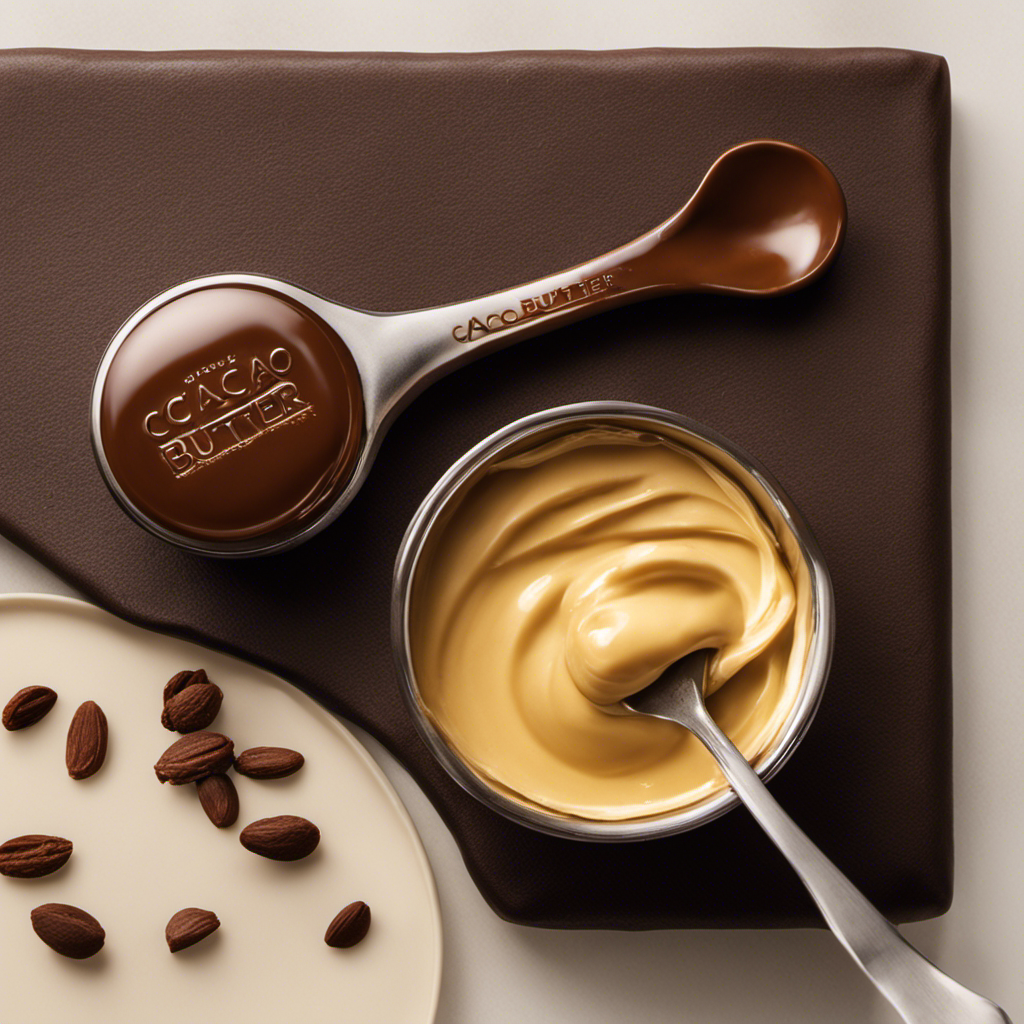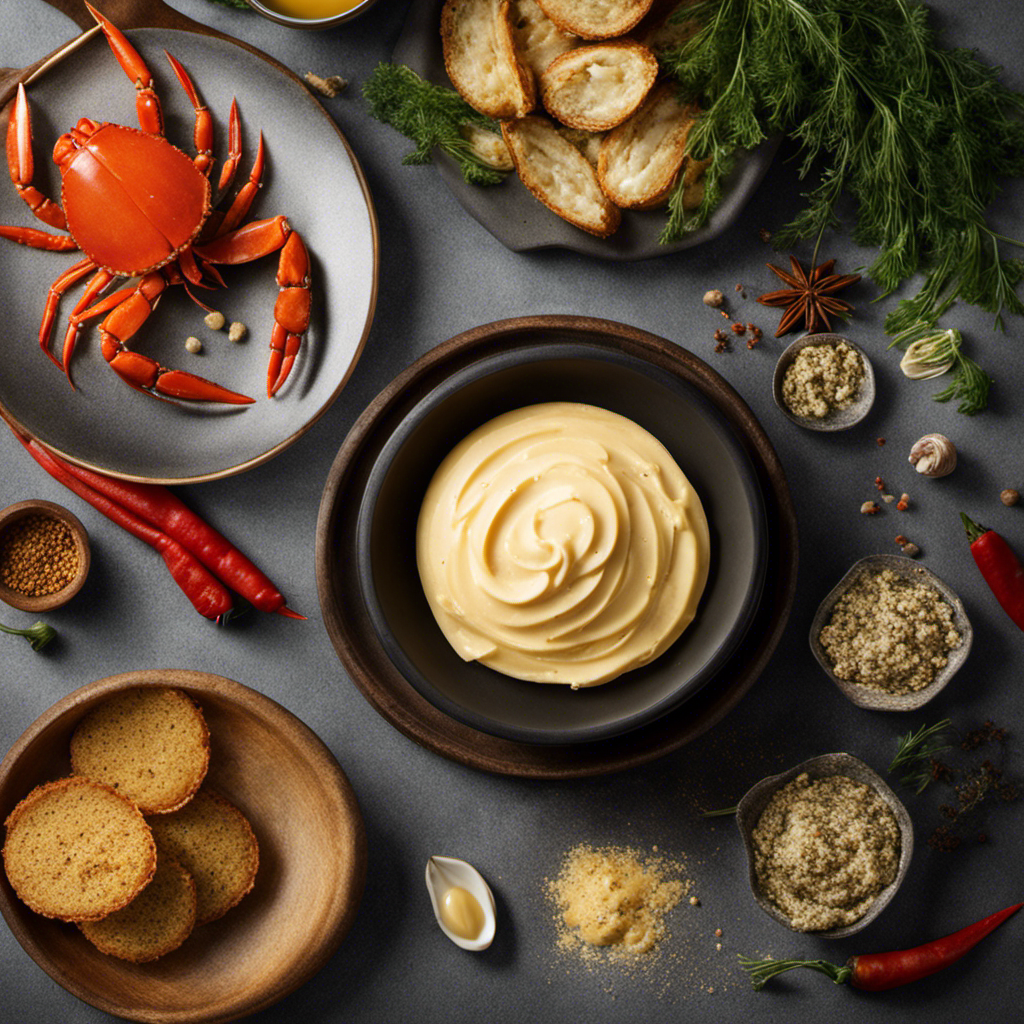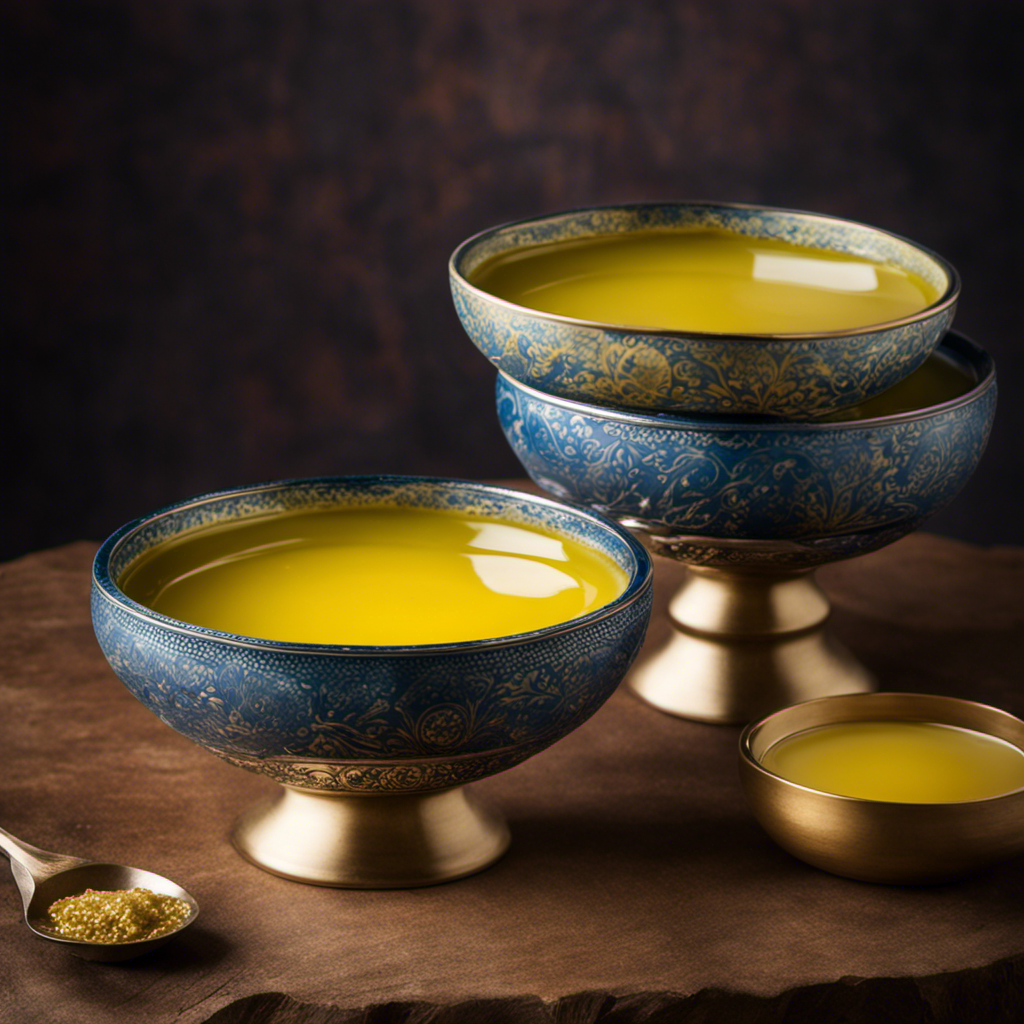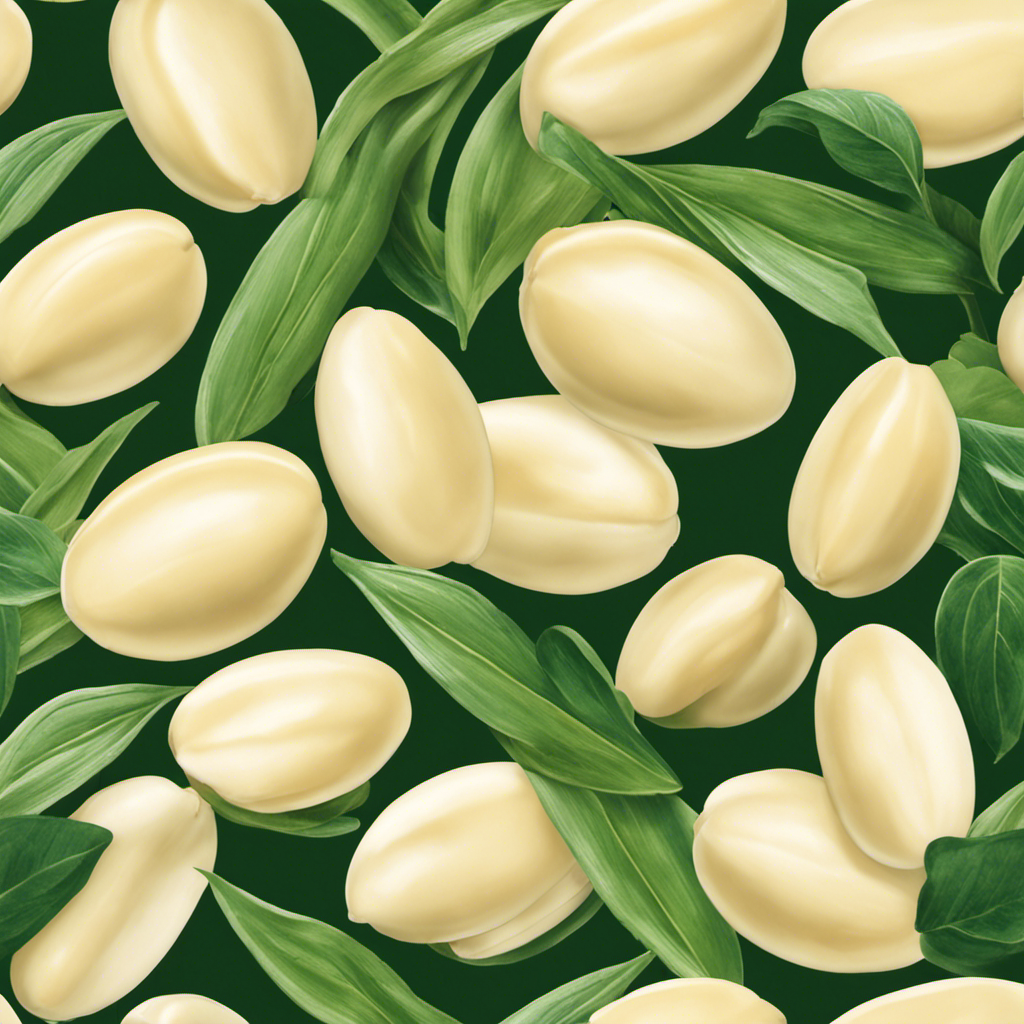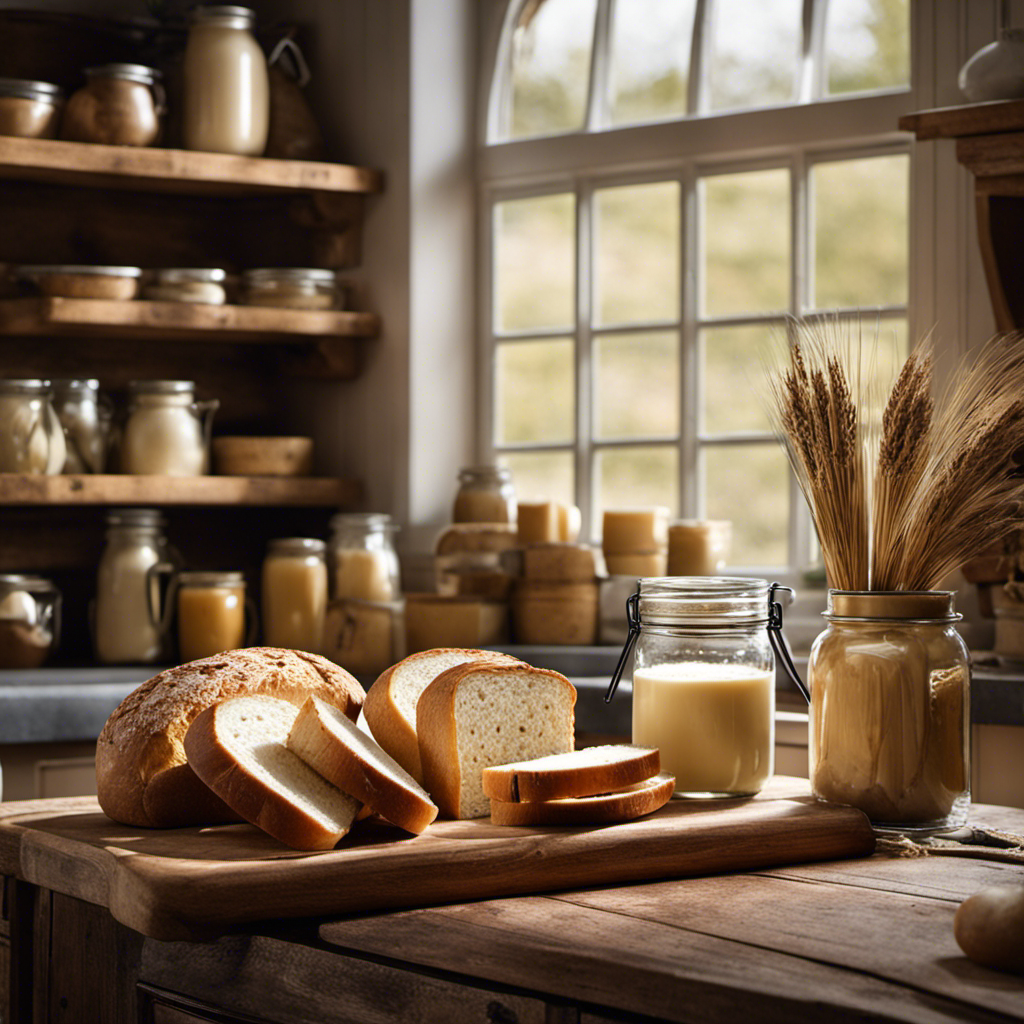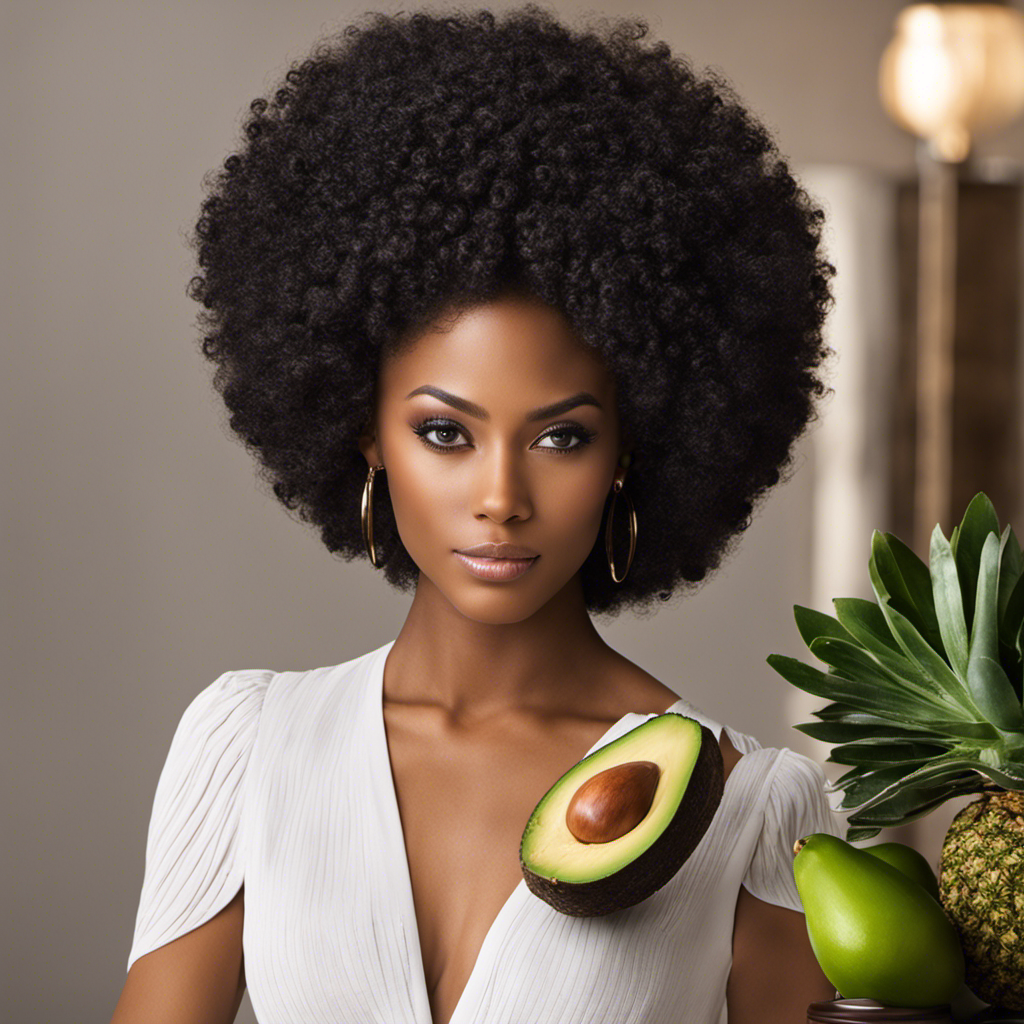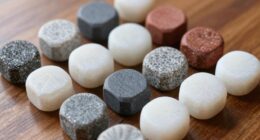I have always been fascinated by the world of food and the endless possibilities it offers.
Today, I want to delve into the topic of cacao butter, a unique ingredient that has intrigued both chefs and health enthusiasts alike.
In this article, we’ll explore the origin, composition, and health benefits of cacao butter, as well as its culinary uses and potential as a vegan substitute.
So, grab a cup of cocoa and join me on this delicious journey.
Key Takeaways
- Cacao butter is derived from the cacao bean and has been used by ancient civilizations like the Aztecs and Mayans.
- It is primarily composed of healthy fats, including saturated and monounsaturated fats, and contains small amounts of vitamins and minerals.
- Cacao butter has antioxidant properties and can be used in culinary creations like baking and making desserts.
- It also has various skincare benefits, such as moisturizing and nourishing the skin, and is used in traditional medicine for its anti-inflammatory properties.
The Origin of Cacao Butter
Cacao butter is derived from the cacao bean, which is native to Central and South America. The origin of cacao butter can be traced back to the ancient Aztecs and Mayans who first discovered the rich and creamy substance within the cacao bean.
These civilizations used cacao butter in a variety of ways, including as a moisturizer for the skin and as a culinary ingredient in their traditional recipes. The Aztecs even considered cacao butter to be a sacred food and used it in religious ceremonies.
Today, cacao butter is still widely used in the cosmetic and culinary industries for its moisturizing properties and unique flavor profile. Its rich history and traditional uses make cacao butter a versatile and valuable ingredient.
The Composition of Cacao Butter
To understand the composition of cacao butter, you might be interested to know that it is primarily made up of healthy fats. Cacao butter is obtained from the cocoa bean through a manufacturing process.
The composition analysis of cacao butter reveals that it is rich in saturated and monounsaturated fats, with a high content of oleic acid. These fats contribute to the smooth and creamy texture of cacao butter. Additionally, cacao butter contains small amounts of vitamins and minerals, including vitamin E and magnesium.
The manufacturing process involves extracting the cacao butter from the cocoa beans, which are roasted and ground to form a paste. This paste is then pressed to separate the cocoa solids from the butter. The resulting cacao butter is a versatile ingredient widely used in the chocolate and cosmetics industries.
Health Benefits of Cacao Butter
When it comes to the health benefits of cacao, there are several key points to consider.
First, cacao is rich in antioxidants, which can help protect the body against free radicals and oxidative stress.
Second, cacao has been shown to have positive effects on skin health, promoting hydration, elasticity, and reducing signs of aging.
Finally, cacao contains compounds that can potentially boost mood by increasing serotonin levels and promoting feelings of happiness and relaxation.
Overall, incorporating cacao into your diet or skincare routine can have numerous benefits for your overall well-being.
Antioxidant Properties of Cacao
The antioxidant properties of cacao butter can help protect the body against free radicals.
As a key ingredient in desserts and baking, cacao butter not only adds a rich and creamy texture, but also brings a range of health benefits.
Antioxidants are substances that combat oxidative stress, which can lead to cellular damage and contribute to various diseases.
Cacao butter contains a high concentration of antioxidants, such as polyphenols and flavonoids, which have been shown to have protective effects on the body.
These antioxidants can neutralize free radicals and reduce inflammation, thereby promoting overall health and well-being.
Incorporating cacao butter into your diet can be a delicious way to boost your antioxidant intake and support your body’s natural defense mechanisms.
Skin Health Benefits
Incorporating cacao butter into my skincare routine has been incredibly beneficial for the health and appearance of my skin. Not only does cacao butter provide deep hydration, but it also contains essential fatty acids that nourish and protect the skin.
When applied topically, cacao butter can help improve hair care by moisturizing the scalp and promoting healthy hair growth. Its rich texture and moisturizing properties make it an excellent conditioner for dry and damaged hair.
Additionally, cacao butter is known for its ability to reduce the appearance of stretch marks. Its emollient properties help to improve elasticity and promote skin regeneration, making it an effective natural remedy for reducing the visibility of stretch marks.
Overall, incorporating cacao butter into my skincare routine has been a game-changer, providing numerous benefits for both my hair and skin.
Potential Mood Booster
Using cacao butter in my skincare routine can potentially boost my mood by nourishing and protecting my skin. Cacao butter is derived from the cacao bean and is rich in fatty acids, antioxidants, and vitamins that promote healthy skin.
The fatty acids in cacao butter help to hydrate and moisturize the skin, preventing dryness and improving its overall texture. The antioxidants present in cacao butter protect the skin from free radicals, reducing the signs of aging and giving it a youthful glow.
However, it is important to note that cacao butter may not be suitable for everyone. Potential side effects include allergic reactions and skin irritation. It is recommended to perform a patch test before using cacao butter extensively.
As for dosage, a small amount of cacao butter can be applied to the skin daily for optimal results.
Culinary Uses of Cacao Butter
Cacao butter can be used in various culinary applications such as baking and making chocolate truffles. It is not only a delicious ingredient but also has other practical uses. Here are some ways you can incorporate cacao butter into your culinary creations:
-
Baking:
-
Substitute cacao butter for regular butter in your favorite cookie or cake recipes to add a rich chocolate flavor.
-
Use it to make velvety smooth brownies or fudgy chocolate bars.
-
Chocolate making:
-
Melt cacao butter and combine it with cocoa powder and sweeteners to create your own homemade chocolate bars.
-
Mix it with other ingredients like nuts or dried fruits to make decadent chocolate truffles.
Cacao butter is not only a versatile culinary ingredient but also a natural skin moisturizer. Its rich texture makes it perfect for nourishing and hydrating dry skin. So, next time you use cacao butter in your desserts, remember that it can also be a treat for your skin.
Cacao Butter Vs. Cocoa Butter: What’s the Difference
When comparing cacao butter and cocoa butter, it is important to consider the differences in quality and processing methods.
Cacao butter is typically made from raw cacao beans that have been cold-pressed to extract the natural oils, while cocoa butter is often derived from roasted cacao beans. This variance in processing can affect the overall quality and flavor of the butter.
Additionally, understanding the nutritional profile and benefits of each butter can help determine which one is more suitable for specific dietary needs or culinary applications.
Quality and Processing Methods
The quality of cacao butter can be influenced by various processing methods. Through careful quality control and the use of different processing techniques, the final product can vary in terms of taste, texture, and overall quality.
Some of the key factors that affect the quality of cacao butter include:
-
Fermentation: Proper fermentation is crucial in developing the desired flavors and aromas in the cacao beans, which ultimately translates into the quality of the butter.
-
Roasting: The roasting process can greatly impact the flavor profile of the cacao butter. Different roasting temperatures and durations can result in varying levels of bitterness and richness.
-
Pressing: The pressing method used to extract the butter from the cacao beans can affect its texture and smoothness. Cold pressing, for example, is known for producing a higher quality butter with a creamy texture.
Nutritional Profile and Benefits
To fully appreciate the nutritional benefits of cacao butter, you should consider its rich source of antioxidants and essential fatty acids. Cacao butter, derived from the cacao bean, is a natural fat that is widely used in culinary applications and as a natural moisturizer. It contains a range of healthy fats, including oleic acid, stearic acid, and palmitic acid. These fatty acids are known to have various health benefits, such as reducing inflammation and improving heart health. Additionally, cacao butter is packed with antioxidants, including flavonoids and polyphenols. These antioxidants help protect the body against free radicals and oxidative stress. Its unique combination of fatty acids and antioxidants makes cacao butter a valuable ingredient for both cooking and skincare.
Here is a table highlighting the nutritional profile of cacao butter:
| Nutrient | Amount per 100g |
|---|---|
| Calories | 884 |
| Total Fat | 100g |
| Saturated Fat | 60g |
| Monounsaturated Fat | 32g |
| Polyunsaturated Fat | 3g |
How Cacao Butter Is Extracted
Extracting cacao butter involves a process in which you crush the cacao beans and separate the fat from the remaining solids. To give you a better understanding of this extraction process, here are two important steps involved:
-
Fermentation: After harvesting the cacao pods, the beans are removed and placed in large fermentation containers. This step allows enzymes to break down the sugars and release the flavor compounds in the beans. It also helps to reduce the bitterness of the beans, resulting in a smoother taste in the final product.
-
Pressing: Once the fermentation is complete, the beans are roasted to further develop the flavor. After roasting, the beans are ground into a paste called cocoa liquor. This paste is then pressed to separate the cacao butter from the cocoa solids, leaving behind a rich, velvety butter.
These extraction processes are often carried out by cacao farmers who follow sustainability practices to ensure the long-term viability of their farms and protect the surrounding ecosystems.
Now, let’s explore how cacao butter is used in skincare products.
Cacao Butter in Skincare Products
Cacao butter is commonly used in skincare products due to its moisturizing and nourishing properties. It is not only beneficial for the skin but also for the hair and lips. The rich texture of cacao butter makes it an excellent ingredient in haircare products, as it helps to moisturize and condition the hair, leaving it soft and manageable. Additionally, cacao butter is often used in lip balms to provide hydration and protection.
Here is a table showcasing the various uses of cacao butter in skincare products:
| Skincare Product | Benefits of Cacao Butter |
|---|---|
| Haircare Products | Moisturizes and conditions hair |
| Lip Balms | Provides hydration and protection |
With its natural properties, cacao butter is a versatile ingredient that can enhance the effectiveness of skincare products, making them more nourishing and beneficial for the hair and lips.
Cacao Butter in Traditional Medicine
As I delve into the topic of cacao butter in traditional medicine, I am eager to explore its medicinal properties, historical uses, and traditional healing practices.
Cacao, known scientifically as Theobroma cacao, has long been recognized for its therapeutic potential due to its abundance of phytochemicals and nutrients.
Throughout history, various cultures have utilized cacao for its healing properties, incorporating it into remedies and rituals to address a range of ailments and promote overall well-being.
Medicinal Properties of Cacao
One of the most fascinating aspects of cacao butter is its potential medicinal properties. This natural fat extracted from cacao beans has been used for centuries in traditional medicine due to its numerous health benefits. Here are some of the medicinal uses and cultural significance of cacao butter:
-
Medicinal uses:
-
Moisturizer: Cacao butter is widely used as a skin moisturizer, thanks to its high content of fatty acids and antioxidants. It helps nourish and hydrate the skin, leaving it smooth and supple.
-
Anti-inflammatory: Cacao butter contains compounds like polyphenols that possess anti-inflammatory properties. It can help reduce inflammation and alleviate symptoms of inflammatory conditions.
-
Cultural significance:
-
Rituals and ceremonies: In many indigenous cultures, cacao butter plays a significant role in rituals and ceremonies. It is viewed as a sacred ingredient, symbolizing abundance, fertility, and spiritual connection.
-
Traditional remedies: Cacao butter has been used in traditional medicine to treat various ailments, including coughs, digestive issues, and even as an aphrodisiac.
Overall, cacao butter not only serves as a valuable ingredient in culinary creations but also holds a special place in medicinal practices and cultural traditions.
Historical Uses of Cacao
To fully understand the historical uses of cacao, you should explore its significance in ancient civilizations and the diverse ways it was incorporated into their daily lives. Cacao has a rich history, with evidence of its use dating back to as early as 1900 BCE.
Ancient civilizations such as the Mayans and Aztecs revered cacao and considered it a sacred plant. They used cacao beans to make a variety of beverages and even used cacao butter in traditional medicine. Cacao butter, derived from the beans, was believed to have healing properties and was used to treat various ailments. Its high fat content made it an effective moisturizer and it was also used in cosmetic preparations.
The historical uses of cacao demonstrate its importance and versatility in ancient cultures.
Transitioning into the subsequent section about traditional healing practices, it is interesting to note that cacao butter played a significant role in traditional medicine.
Traditional Healing Practices
Derived from the cacao beans, cacao butter was believed to have healing properties and was used in traditional medicine by ancient civilizations. It holds a significant place in the history of traditional medicine due to its various therapeutic applications.
Here are some notable uses of cacao butter in traditional healing practices:
-
Skin Care: Cacao butter was used to moisturize and protect the skin, promoting healing and preventing dryness.
-
Digestive Health: It was believed to aid digestion and relieve symptoms of indigestion and stomachaches.
These traditional uses of cacao butter demonstrate its historical significance in traditional medicine. As we delve into its modern applications, it becomes clear how this versatile substance has evolved and found new roles beyond its historical roots.
Now, let’s explore the fascinating realm of cacao butter as a vegan substitute.
Cacao Butter as a Vegan Substitute
Cacao butter can be used as a vegan substitute for dairy butter in many recipes. It is a versatile ingredient that offers numerous benefits in vegan baking.
One of the key advantages is its creamy texture, which is similar to that of dairy butter. This allows for easy incorporation into various recipes, such as cookies, cakes, and brownies.
Cacao butter also adds a rich and decadent flavor to baked goods, enhancing their taste. In addition, it is packed with healthy fats, antioxidants, and minerals like magnesium and iron. These nutrients contribute to a well-balanced vegan diet.
Furthermore, cacao butter has a high melting point, making it ideal for creating smooth and glossy chocolate coatings.
Overall, cacao butter is an excellent choice for vegan baking due to its taste, texture, and nutritional benefits.
How to Store Cacao Butter
Make sure you store cacao butter in an airtight container in a cool, dry place to maintain its freshness and quality. Proper storage is essential to preserve the flavor and aroma of cacao butter for an extended period.
Here are some important tips to keep in mind when storing cacao butter:
-
Temperature Control:
-
Store cacao butter in a temperature range of 60-70°F (15-21°C).
-
Avoid exposing it to direct sunlight or heat sources, as it can cause the butter to melt or spoil.
-
Moisture Protection:
-
Keep cacao butter away from moisture and humidity.
-
Ensure the container is tightly sealed to prevent any moisture from seeping in.
Following these guidelines will help prolong the shelf life of your cacao butter, ensuring that it remains fresh and ready to use for all your culinary creations.
Cacao Butter Recipes and Ideas
Are you looking for creative ways to incorporate this rich and velvety ingredient into your favorite recipes? Look no further! Cacao butter, with its smooth texture and chocolate aroma, is not only perfect for desserts but also for beauty products. Here are some ideas to inspire you:
| Dessert Recipes | Beauty Products | Other Uses |
|---|---|---|
| Chocolate Truffles | Lip Balm | Massage Oil |
| Raw Brownies | Body Butter | DIY Candles |
| Hot Chocolate | Bath Melts | Homemade Soap |
| Chocolate Bark | Body Scrub | Aromatherapy |
| Chocolate Mousse | Hair Mask | Moisturizing Lotion |
Whether you’re craving a decadent treat or want to pamper yourself with luxurious skincare, cacao butter has got you covered. From indulgent chocolate truffles to nourishing body butter, the possibilities are endless. So go ahead, experiment with cacao butter and elevate your desserts and beauty routine to a whole new level!
Frequently Asked Questions
Is Cacao Butter the Same as Cocoa Butter?
Yes, cacao butter and cocoa butter are the same thing. They both come from the cacao bean and are used interchangeably in recipes. However, cacao butter is different from shea butter, which is derived from the shea tree.
Can Cacao Butter Be Used as a Substitute for Dairy Butter in Baking?
Yes, cacao butter can be used as a substitute for dairy butter in baking. It has a rich, chocolatey flavor and is vegan-friendly. When substituting, use a 1:1 ratio and melt the cacao butter before adding it to the recipe.
Does Cacao Butter Have Any Health Benefits for the Skin?
Cacao butter has several health benefits for the skin. It moisturizes, nourishes, and helps improve skin elasticity. Incorporating cacao butter into your skincare routine can promote soft, supple, and healthy-looking skin.
How Long Does Cacao Butter Typically Last When Stored Properly?
Cacao butter, when stored properly, can last for up to two years. It’s like a time capsule, preserving its shelf life. Maintaining a cool, dark place and sealing it tightly will ensure its longevity.
Are There Any Traditional Medicinal Uses for Cacao Butter?
Traditional uses of cacao butter in medicine include promoting cardiovascular health and reducing inflammation. However, it’s important to note that excessive consumption can lead to weight gain and high cholesterol levels.
Conclusion
In conclusion, cacao butter is a versatile and nutritious ingredient that has been used for centuries. With its rich composition of healthy fats and antioxidants, it offers numerous health benefits and can be used in a variety of culinary creations.
It is interesting to note that cacao butter contains approximately 59% saturated fat, making it a valuable source of energy. This statistic emphasizes the importance of consuming it in moderation and incorporating it into a balanced diet.
So, next time you’re looking for a healthy and delicious ingredient, consider adding cacao butter to your pantry.
